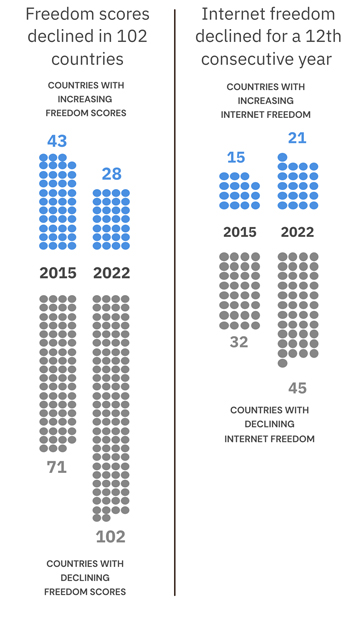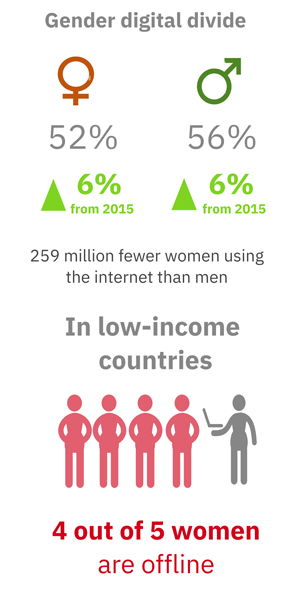 Information access is a fundamental driver of many of the goals in the United Nations’ 2030 Sustainable Development Agenda, yet many countries are struggling to make progress. A new analysis has found that statistical indicators of freedom and gender equity — two pillars of meaningful access to information — show decline and stagnation midway through the Agenda put forth in 2015.
Information access is a fundamental driver of many of the goals in the United Nations’ 2030 Sustainable Development Agenda, yet many countries are struggling to make progress. A new analysis has found that statistical indicators of freedom and gender equity — two pillars of meaningful access to information — show decline and stagnation midway through the Agenda put forth in 2015.
The findings come from research into seven years of data by the Technology & Social Change Group (TASCHA) at the University of Washington and the International Federation of Library Associations and Institutions (IFLA). The organizations have collaborated for several years on Development and Access to Information (DA2i), a series of reports that monitor countries’ progress toward meeting their commitments to provide meaningful access to information.
The researchers released their findings and new data visualization tools March 16 during the U.N. World Summit on the Information Society. The new tools, DA2i Regional Dashboards, track the progress of 29 selected indicators of social development from the adoption of the U.N. Agenda in 2015 to 2022 or the most recent available data. The data shows that while most countries have steadily brought more people online, freedom and human rights have regressed, and progress toward gender equity has been meager, particularly in low-income countries.
Among the findings:
Freedom is on the decline: Measurements of civil and political freedom have declined across nearly all regions, especially in North Africa, Southeast Asia and Southern Asia. Civil rights have declined the most, specifically freedom of expression and association. Political pluralism and functioning governments have also declined. Overall, 102 countries scored lower in 2022 than they did in 2015 in Freedom in the World scores whereas only 28 countries scored higher. Global internet freedom showed a similar decline: out of 70 countries, 45 scored lower, and only 21 improved their scores. The steepest drops in internet freedom were concentrated in the same regions where political and civil freedoms have been eroded.
 There is little progress on gender equity: On the surface, data shows a slight improvement in many gender equity indicators across the globe in the last seven years; however, the researchers stress that two important caveats are needed to contextualize these findings. First, most data on gender equity indicators is from 2020 or older, with few countries reporting data for 2021 or 2022, so the average decrease in gender inequality is an incomplete picture of the effects of the pandemic and on progress toward Sustainable Development Goal 5, achieving gender equality and empowering all women and girls. Secondly, progress is still inadequate. For example, though women’s participation in science and politics has increased globally, it’s only a 1 and 2 percentage point increase, respectively. Meanwhile, women are still faced with higher joblessness rates than men, and young women are twice as likely as young men to not be in education, employment, or training. And whereas women and men have made similar gains in internet usage since 2015, more women are still offline than men, and in low-income countries, 4 out of 5 women remain offline.
There is little progress on gender equity: On the surface, data shows a slight improvement in many gender equity indicators across the globe in the last seven years; however, the researchers stress that two important caveats are needed to contextualize these findings. First, most data on gender equity indicators is from 2020 or older, with few countries reporting data for 2021 or 2022, so the average decrease in gender inequality is an incomplete picture of the effects of the pandemic and on progress toward Sustainable Development Goal 5, achieving gender equality and empowering all women and girls. Secondly, progress is still inadequate. For example, though women’s participation in science and politics has increased globally, it’s only a 1 and 2 percentage point increase, respectively. Meanwhile, women are still faced with higher joblessness rates than men, and young women are twice as likely as young men to not be in education, employment, or training. And whereas women and men have made similar gains in internet usage since 2015, more women are still offline than men, and in low-income countries, 4 out of 5 women remain offline.
More of the world is online: Across all regions, there has been significant progress in connectivity indicators, with the most substantial gains from Northern African, Southern Asian and Western Asian countries. In 2022, roughly 60% of the world’s populations used the internet, a dramatic increase from 40% in 2015. But the researchers again note that context is important when assessing these numbers. Less than a third of people in Sub-Saharan Africa and Oceania are online, and overall, 2.7 billion people remain offline. Furthermore, though investments in connectivity infrastructure are important, they aren’t enough to grant rights to internet access, especially if access to the internet and to devices isn’t affordable.